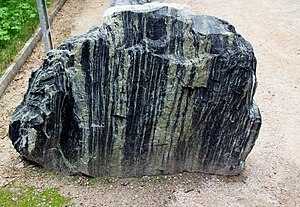Epidiorite
| Metamorphic rock | |

Amphibolite
|
|
| Composition | |
|---|---|
| Amphibole |
Amphibolite (pronunciation: /æmˈfɪbəlaɪt/) is a metamorphic rock that contains amphibole, especially the species hornblende and actinolite, as well as plagioclase. A holocrystalline plutonic igneous rock composed primarily of hornblende amphibole is called a hornblendite, which is usually a crystal cumulate rock. Rocks with >90% amphiboles which have a feldspar groundmass may be a lamprophyre.
Amphibolite is a grouping of rocks composed mainly of amphibole and plagioclase feldspars, with little or no quartz. It is typically dark-colored and heavy, with a weakly foliated or schistose (flaky) structure. The small flakes of black and white in the rock often give it a salt-and-pepper appearance.
Amphibolites need not be derived from metamorphosed mafic rocks. Because metamorphism creates minerals based entirely upon the chemistry of the protolith, certain 'dirty marls' and volcanic sediments may actually metamorphose to an amphibolite assemblage. Deposits containing dolomite and siderite also readily yield amphibolites (tremolite-schists, grunerite-schists, and others) especially where there has been a certain amount of contact metamorphism by adjacent granitic masses. Metamorphosed basalts create ortho-amphibolites and other chemically appropriate lithologies create para-amphibolites.
...
Wikipedia
